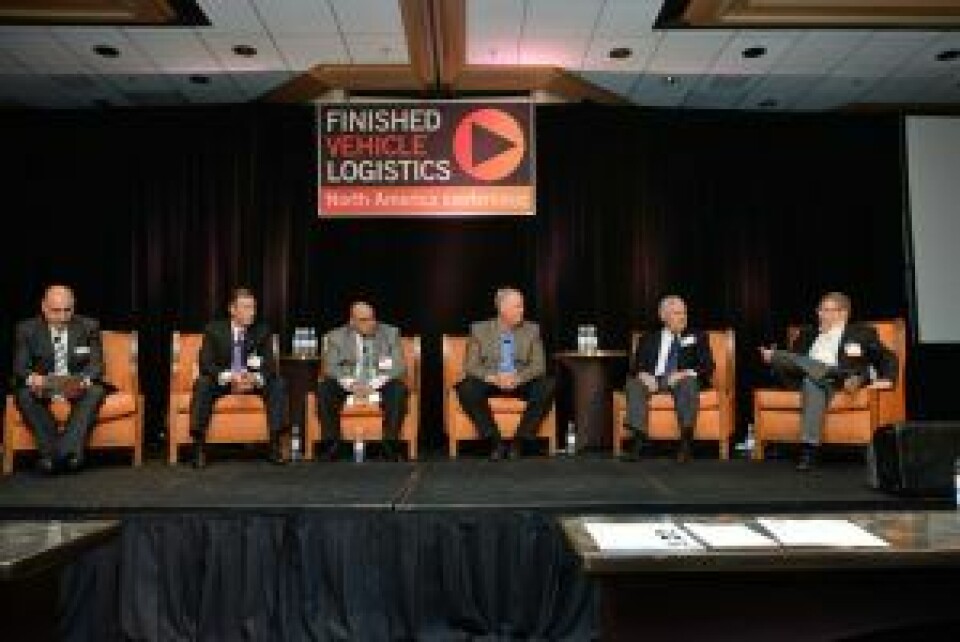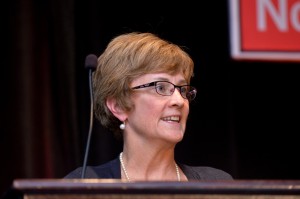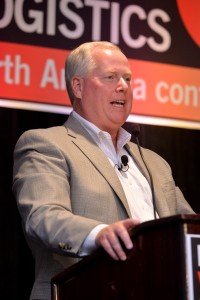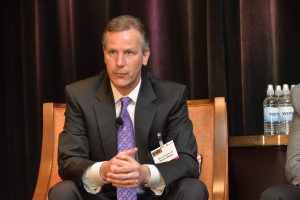What’s keeping US outbound executives awake in the middle of the night?

A severe disruption to rail capacity this year has left thousands of vehicles stranded in North America, leading some carmakers to look more carefully at their road and short-sea shipping options. Executives discussed their long-term plans at this year’s conference in California.
The prospect of modal shifts for finished vehicle distribution in North America was top of the agenda for many supply chain executives at this year’s Finished Vehicle Logistics North America conference, held in Costa Mesa, California. With the industry still reeling from the impacts of arctic weather conditions this past winter, which have put a heavy strain on the rail network in the US and Canada, coupled with the projected expansion of production and exports from Mexico, there was debate about the extent to which carmakers might increase their use of road transport and short-sea shipping. The outlook from outbound executives was that the modal shifts would not just be short-term reactions to the crisis, but could in some cases lead to long-term changes.
“I think that the fallout from this year’s rail issues and the growth in Mexico is going to be that every OEM will want more options in the future,” said Bryan Burkhardt, director of North American and intercontinental vehicle logistics at General Motors. “In practical terms, that will mean more short-sea shipping [from Mexico to the US and Canada], and more direct trucking [from US and Canadian plants].”
Steve Tripp, head of worldwide vehicle distribution for the Chrysler Group, expressed worry that the shortages witnessed so far this year were systemic rather than simply the result of poor weather. Railcar (wagon) shortages, he said, “are the first thing I think about when I wake up in the morning, the last thing I think about before I go to sleep, as well as most of the time in between.”
With a backlog across the industry of some 150,000-170,000 vehicles still outstanding because of the rail issues, Tripp speculated that carmakers might respond with radically altered outbound networks, including moving vehicles by truck for distances of 2,000 miles or more by deploying “relay” points for drivers to move the same truck.
Brian Mason, national manager for strategic planning and communications at Toyota Logistics Services, said that the carmaker had been forced to shift 29,000 vehicles since January off standard transport routes, mainly as a result of the problems with rail. The beneficiary of these changes has been trucking, and Mason said that some of modal shifts could end up being permanent. “We have changed some assumptions,” he said. “We used to look to use rail to move vehicles distances of 200-300 miles (320-500km) or more. But now we have found that trucking can be cost competitive for a radius of 500, 600 and even 700 miles.”

Another area where modal shifts may occur are for exports from Mexico to the US and Canada. With as many as seven new plants forecasted to come online between 2013 and 2020, the expected volume heading north of the border will rise substantially. Although executives said that railcar capacity out of Mexico is currently in reasonable balance, there are concerns over whether supply will rise in line with production and exports. Sergio Gutierrez, head of Mexico for Wallenius Wilhelmsen Logistics, said that the industry was “surviving” at today’s volumes. “But the real increases have not yet come, and we will definitely have to catch up our rail capacity,” he said.
Capacity concerns at ports and on the road
Executives acknowledged that rail was not the only mode that has or could suffer from capacity shortages or investment constraints. Mike Riggs, chairman of Jack Cooper Holding, pointed to financing issues, regulatory changes and driver shortages as barriers to increasing the efficiency of the trucking sector.
Previously, said Riggs, the answer was simply to buy more trucks, but lenders are now demanding higher down payments. “If you imagine buying a house and someone tells you that you have to put 33% or even 50% down, how does that change how many houses are sold? That is kind of what is going on in the equipment world. It is much more difficult now than it was.”
16 May 2014: Follow the links below and check back in the coming days for additional news from throughout the conference.
*Watch videos of the key presentations here
Riggs said the industry’s efficiency was also hit by stricter safety monitoring for drivers’ records as well as reductions in the number of hours a drivers could drive before mandatory rests. “I will challenge anyone to find any period in history where there has been more negative regulation imposed on any industry than there has been on trucking in the last 3-5 years,” he said. “It is stunning and ware having to live with this in an era of driver shortages.”
There are also constraints and pressure on North American ro-ro ports. In Mexico the issue is perhaps most obvious, where significant investments are needed to offer OEMs suitable terminal options beyond the east coast port of Veracruz, which currently handles around 80% of exports and is very crowded, according to WWL’s Gutierrez.
Port development was a major theme north of the border as well. Bill Kerrigan, an industry consultant and also program manager for finished vehicle logistics at the AIAG, noted that the sector faced constraints at many of its major ports in both southern California and the northeast. Jan Bures, executive vice-president of aftersales and services at Volkswagen Group of America, said that the carmaker was having issues in getting vehicles into the country, particularly through the port of San Diego. “This is because of uncertainty in moving through the Panama Canal. If you don’t hit your assigned timeslot, then you have to get back in line, and you often lose around four days,” said Bures. “It’s a big issue for us.”
There are also significant changes happening up and down each coast. Volkswagen is in the process of tendering its port network in the southeast US. Mercedes-Benz is changing locations in the Los Angeles area to combine a large terminal with a training centre and regional offices. Toyota has added two new ports for vehicle exports at Baltimore, Maryland and at Greys Harbor in Washington state. BMW is changing the facilities that it uses for port processing at Baltimore as well.
With all of the potential changes and constraints, the theme that came through from most speakers was a need for more collaboration in all areas of the industry, including benchmarking performance, integration between transport modes and working together to support beneficial regulation. Both Kerrigan and Marty Colbeck, head of east coast sales at port processor AWC, encouraged the sector to set and share more standard processes.
“We should do more to establish set KPI and standards in vehicle processing that help us to understand all measurements and timings at ports, which would greatly help us to improve,” Colbeck said.

Rory Anne Hepner, general manager of vehicle distribution and logistics at Mercedes-Benz USA, said that the carmaker was looking to rebuild some of the relationships with carriers that she admits were hurt during the cost cutting years of the economic crisis. As part of that, she said that Mercedes-Benz was doing a lot more to study and standardise data to verify that things are done properly.
“From a KPI standpoint, we are doing more compliance with how truckers carry our product in a more collaborative way,” she said. “We are also having meetings to develop ways of establishing how to build loads that would benefit our trucks, rather than just processing vehicles and letting them sit, which is something we never did before.”
Others called for increases in the use of analytics and intelligent data. Nicole Humphrey, manager of business intelligence and analytics at Vascor, said that the industry would benefit greatly from sharing more information on vehicle distribution and logistics. She pointed to a survey that showed that just 8% of OEMs and 5% of logistics providers were using analytics to measure logistics.
Perhaps even more basic to the sector was that carmakers have and will continue to depend on all transport modes to manage the growth in sales and production, as well as to resolve the current backlogs in the sector. Both Chrysler’s Tripp and Toyota’s Mason maintained that rail would remain a critical part of their outbound distribution networks, but that there might a need to see where more rail flows might be consolidated at hubs from which trucks might carry out final distribution over distances longer that those common today. Likewise, in Mexico, executives maintained that the sector was going to need to invest across all capacity, including rail, ports and road, to meet rising demand.
“Nobody wants to lose their volume, but the only way to move all the volume up here [to the US] is going to be to work together,” said WWL’s Gutierrez.
North American growth
From a macroeconomic picture of the sector, the recovery of the US and North American automotive industry continues to take hold. Production across the region reached 16.2m light vehicles in 2013, which will increase to 18.8m units by 2020, according to Brandon Mason, leader of Autofacts America at consultancy PwC. Sales in the US, meanwhile, are expected to reach 16.2m units this year, up from 15.5m last year – a number that Mason believed would still be hit despite the economic impact of the wintry weather earlier this year.
But the situation is not equally good across the region. For example, PwC expects Canada to lose two plants by 2020 as the industry struggles with the strong Canadian dollar, with production dropping from 2.4m units last year to 1.6m by decade’s end.
Most of that production will shift to the US and especially Mexico. Brandon Mason said that the US would see production rise from 11m to 13.2m by 2020 although most of this increase would come from making better use of plant capacity, rather than from many new plants. In Mexico, however, seven new plants are expected. That includes the new plants already opened in recent months by Nissan, Mazda and Honda, along with the Audi plant. Gutierrez added that BMW was expected to announce an additional plant in Mexico, while there has also been discussion about Mercedes adding production in Mexico, perhaps together with Nissan.
“Mexico is growing because of its low labour, but also logistics savings from serving the US compared to Asia, as well as because of free trade agreements with Latin America and Europe,” said PwC’s Mason.
Perhaps worryingly, however, Mason pointed to signs that the US sector was returning to some bad habits from before the economic crisis. Vehicle inventory, for example, has grown from a low of 30 days supply following the crisis in 2009, back to around 90 days currently. Likewise, Mason also said that the subprime financing market is also starting to creep back up for automotive sales, which could lead to problems should there be sharp rises in interest rates and any slowdown in sales.
However, on the whole the market and sector look healthy, with steady sales increases anticipated and high production capacity utilisation at plants, which Mason said has been running at more than 90% across North America (75-80% is usually considered the breakeven point).
Rail is struggling to catch up
By the far biggest concern for many OEMs this year for vehicle logistics has been the rail disturbances. The impact on the distribution of vehicles has been substantial, with thousands of vehicles delayed in each of the past several months. And it would appear that the situation is still months away from being resolved at the earliest.
“As a result of the weather, and I believe a slow reaction time on the part of the railroads, the system has been backlogged,” said Tripp. “The rail system today is like a pipeline that can just about handle what we build today. Now that we have a backlog, we can’t extend that pipe and catch up.”

Executives expressed concern over the railways’ projections that carmakers should be able to overcome this backload during their traditional plant shutdowns in the summer. “Our inventory of vehicles waiting to move by rail is 125% above the norm. It is going to take a few ‘July shutdowns’ to get the issue right,” said Dennis Manns, vice-president of logistics at American Honda.
Indeed, Steve Tripp worried that if the backlog couldn’t be cleared by the summer, then the current situation could become a way of life for the industry. “If we don’t get out of this during the summer, we will then get into the rush at the end of the year, and then the winter will come again and we will be back where we started,” he said.
The reason for the rail shortages are highly technical, combined with a demand for bi-level wagons (the double deck equipment used mainly to haul SUVs, compared with tri-levels used for smaller vehicles). Linda Brandl, vice-president and general manager for automotive at Union Pacific, explained that sub-zero Fahrenheit temperatures across much of the network had a terrible impact on the air-braking system used by railways, which cut the capacity of the system virtually in half. “Rail also found that the demand component, particularly for bi-levels, was 120% higher than what OEMs had forecasted,” she said. “I don’t know of any other mode where demand could be double what was expected and then lose half of its capacity and still maintain the same velocity.”
 UP's Linda Brandl said that weather combined with a huge demand for bi-level railcars has hurt rail velocity this year
UP's Linda Brandl said that weather combined with a huge demand for bi-level railcars has hurt rail velocity this year
Dave Fleenor, assistant vice-president of automotive for BNSF Railway, added that the sector has also been hit by the demand of other commodities. With the rise in price of natural gas, there has been a huge surge in coal consumption, while there were also other agricultural demands. It is not only that these commodities might represent more revenue for several railways; their delivery is more urgent, in some cases. “If we don’t move the coal, the electricity would go off. And if we didn’t move grain to South Dakota, we were told that there wouldn’t be a harvest this year,” he said.
Fleenor added that the rail sector was spending tremendous amount of money to improve the network. “We have to invest, but it is very risky, big gambles. We have record amounts of capital spending right now, but there is no easy fix. For us to return to 2012 capacity levels, it is more than a year away,” he said.
OEM executives accepted that the main cause of the disturbances was unprecedented weather. But they also expressed frustration with the lack of solutions. “The temperature is heating up with this stuff. If the product was tomatoes and vegetables, they would all be rotten and it would be five different guys sitting on stage right now,” said Manns, referring to the pressure from top management. “I don’t want weather reports, I need solutions.”
Bryan Burkhardt agreed. “We are not seeing any recovery so far. I would challenge the railroads and say that we can’t keep running the same play,” he said. “Our brand and manufacturing vice-presidents don’t want weather reports either.”
Brian Mason suggested that some of the root causes in the rail supply issue might lie in the changing patterns of North American production. For example, in 2007 Toyota met around 54% of vehicle sales in the region from North American plants. This year, with the carmaker’s production in the US, Canada and Mexico expected to reach 1.84m vehicles, the proportion will increase to around 73%.
“Is this changing production pattern contributing to the asset shortage, particularly for rail?” asked Mason.
Road takes the strain off the trains
The short-term solution so far has been to store vehicles in temporary space and to move as many as possible by road until rail catches up. The question now is whether those shifts will be permanent on a large scale. Mason said that the company had experienced “a good story” in moving vehicles longer distances by truck, including high flexibility and good quality levels. The extra costs involved were compensated in part by faster lead times “We are looking at how we can work more closely with our trucking carriers to help improve their fleet planning, including multi-year agreements that would allow them to better invest in equipment,” he said.
Tripp said that his idea for a relay team for trucking vehicles long distance should be taken seriously. From Detroit to Los Angeles, for example, he said the same truck could swap drivers in segments of anything from 300-600 miles each. “Each driver would make a round trip, moving west with a loaded trailer and then back east empty. The truck could be passed over like a baton.”
In such a system, Tripp suggested that lead times could be reduced from the ten days it typically takes to move vehicles by rail from Detroit to LA to as little as two days, which he said would have a massive impact on both inventory carrying costs and on customer satisfaction. He also suggested that lower skilled and less expensive drivers could be used for some of the relay legs, since complex loading and unloading would not be required. He added that if the industry were to switch to a convertible trailer model – such as those proposed by CTM – then the trucks could return carrying containers rather than moving empty.
 GM's Burkhardt expected that there would be fallout from the rail shortages
GM's Burkhardt expected that there would be fallout from the rail shortages
Mexico by land and by sea
Mexico continues to dominate talk about much of the sector’s future growth. According to figures from PwC Autofacts, Mexican light vehicle production will rise from 2.8m units last year to at least 4m units by 2020. WWL’s Gutierrez cited forecasts for production of total vehicles that expect volume to grow from 3m last year to 4.88m vehicles by 2018, with 87% projected to be exported by then.
The number of vehicles expected to leave Mexico by both rail and ocean should both rise. Gutierrez predicted that rail-based vehicle exports, which go to the US and Canada, would increase from 1.67m units in 2013 to 2.81m by 2018, while ocean volume, which moves globally including to Latin America and Europe, would increase in the same period from 830,000 vehicles to 1.41m.
The share of that ocean shipping moving by short sea to the US and Canada should increase as carmakers turn more to regular services. In recent months, for example, MOL has commenced regular services from both Veracruz on the east coast and Lazaro Cardenas on the west coast, serving both Honda and Mazda. WWL has also increased its services, including a new route out of Altamira on the west coast north of Veracruz to serve General Motors. Chrysler has also recently been moving vehicles out of Mexico to the port of Baltimore, although still on a ‘spot’ basis. “We were told it was a one time move,” said Colbeck from AWC, which has a facility in Baltimore. “That one time has now turned into five or six vessels.”
 WWL's Gutierrez said that more investment was needed in Mexican ports beyond Veracruz
WWL's Gutierrez said that more investment was needed in Mexican ports beyond Veracruz
There are, however, significant port capacity strains, particularly as Veracruz handles nearly 80% of port-based exports from Mexico. Gutierrez said that the port is nearly full and that manufacturers would need to look at other port options. Rand said that his company is now investing substantially in its terminals at both Lazaro and Altamira. The latter in particularly, he said, was a much cleaner port than Veracruz.
Mexico, it would appear, has not been greatly impacted by the rail wagon issues this year. “Mexico has been a bright spot for GM, as UP has done a good job of protecting us from railcar issues,” said Burkhardt. Chrysler’s Tripp agreed, but both he and Burkhardt said that the big question remained over what the growth of volume would mean for the rest of the North American network. “It is a question, but I think that it is very solvable, including expanding existing ports,” said Tripp.
Beyond capacity, executives also pointed to vandalism and security issues in Mexico. Manns admitted, for example, that Honda’s very first rail shipment out of its plant in Celaya was hit by vandalism. Burkhardt also said that vandalism was an issue for GM, particularly whenever vehicles were not moving.
Gutierrez and Amport’s Rand added that while there were security issues, operations were generally of a high quality. Although Lazaro Cardenas was in an area considered very dangerous, the Amports terminal had never had a problem or a single car stolen, for example.
Changing port networks
Mexico’s ports are not the only ones to see more volume and to face capacity issues. Even with growing North American production, there have been increases in imports, as well as for exports out of the US. The Volkswagen Group, for example, expects its imports from Europe to the US to increase from around 248,500 units in 2013 to 350,000 units by 2018, according to Jan Bures. At the same time, the carmaker will increase the number of vehicles that it exports from Mexico to the US from nearly 246,000 last year to 310,000 by 2018. Such expansion will put more pressure on the carmaker’s import network and its rail network, which it uses extensively from Mexico and in the US.
"For much of my 23 year career with Mercedes we have been looking for a new location in this area, which we have finally found" - Rory Hepner, Mercedes-Benz USA
Other carmakers were also looking at making port adjustments in the US. Rory Hepner revealed that Mercedes-Benz was finally moving its terminal location in southern California following years of capacity constraints. The carmaker will move its terminal from Carson to a facility close to Long Beach that will provide more than 1m sq.ft of space (93,000 sq.m) and will create an integrated base that includes import processing and accessory installation operations. “For much of my 23 year career with Mercedes we have been looking for a new location in this area, which we have finally found and which will become a full west coast campus for Mercedes-Benz,” she said.
Export operations at ports are another growing area for carmakers in the US. Brian Mason said that Toyota expected to reach 107,000 units this year and 124,000 next year. But the transport and processing of this volume is fragmented and inefficient. For example, Toyota uses around 13 ports and 11 shipping lines to move exports compared to five ports and five shipping lines to import around 900,000 vehicles. “The service and quality levels vary greatly between imports and between ports,” he said. “It’s a challenge to manage this complexity.”
Note that Finished Vehicle Logistics is partnering with AIAG to host a one day conference this summer on import and export flows, held at the port of Baltimore. Keep checking this site for more information on Import/Export North America 2014.
A shortage of craftsmen on the road
Finally, while the truck sector appears to have benefited from the rail shortages this year, there were concerns expressed about the difficulties in using and expanding truck capacity, as well as in recruiting new drivers.
With its takeover of Allied completed this quarter, Jack Cooper has the biggest fleet in North America. However, the fleet that it inherited from Allied is not as big as initially anticipated, as between 500 and 700 trucks look like they are heading for the scrap yard, according to Mike Riggs.
However, that still leaves about that many extra trucks available to Jack Cooper to meet additional volume. And indeed, while Riggs and others pointed to financing issues, there was a general consensus that road haul capacity was not a major problem in the US.
“I don’t want to say that I don’t have haulaway problems, but mainly I don’t have a haulaway problem, besides a few big gaps,” said Tripp.

The driver issue, on the other hand, is becoming more critical. United Road president Kathleen McCann said that demographics risked creating even more of a shortage. Quoting figures from the American Trucking Association (ATA), McCann said that 20% of drivers are now between 55 and 65, while only 8% are under 30 years of age. Given the number of years it takes to become proficient as a car hauler, this is of particular concern as volume movements climb toward 20m in the next decade.
“It is really important to note that the timeframe to become proficient as a car hauler is not months, it is years, and it really takes finely tuned training that demands us to be very patient,” she said.
It is that training and special skill set that distinguishes car-hauling professionals as a different breed compared to normal freight drivers, according to McCann. She pointed out that they were often handling cargo that could be worth anything from $500,000 to $1m dollars at a time.
“These professionals are also craftsmen, car lovers, they have specific geospatial and problem solving skills, and are very comfortable with technology,” she said. “These are honed skill sets that you can’t find in other drivers and they are in short supply today; that should matter to everyone.”
United Road is now working with truck driving schools, canvassing people with military backgrounds and encouraging the families of its existing drivers to consider it as a profession.
Richard Binkley, president of US Autologistics, agreed over the problem of recruitment, revealing that his company was struggling to recruit drivers even though it paid them around $92,000 per year, though he did add that the company had low staff turnover. In the past, he said, there had been no need to go on recruitment drives but now the company was using social media and a new website to get the message out. He added that US Autologistics doesn’t hire drivers with fewer than two years experience, but that it might need to consider looking more carefully at driver graduate programmes.
 Jack Cooper's Mike Riggs is hoping to increase the allowable length and loaded weight of car haulers in the US
Jack Cooper's Mike Riggs is hoping to increase the allowable length and loaded weight of car haulers in the US
“That would allow carriers to load an extra car, and to reduce cycle time and the inventory bubble,” he said.
Riggs said that he recently held meetings with railways, including Norfolk Southern, which he said had been more positive than in the past when the rail sector had lobbied against such changes.
Binkley said that the industry was closer than it had ever been before to making the change. “We have met with a number of congress members on the transportation committee in Washington DC, and we have had a positive response,” said Binkley. “We have also had strong support from OEMs, and have delivered a study on how the extra weight and length would not impact safety. We will be back down in Washington next month, and I believe – I have to believe – we are closer than we have ever been before.”
 GM’s Bryan Burkhardt concluded that GM and other carmakers also still had plenty of opportunity to take waste out of the outbound logistics network, including by better combining transport modes and routes. “For finished vehicle logistics specifically, we are growing our network design capabilities,” he said. “To the extent that we can better engineer the network, we can take waste out of the system.
GM’s Bryan Burkhardt concluded that GM and other carmakers also still had plenty of opportunity to take waste out of the outbound logistics network, including by better combining transport modes and routes. “For finished vehicle logistics specifically, we are growing our network design capabilities,” he said. “To the extent that we can better engineer the network, we can take waste out of the system.
“Co-loading with rail is also an opportunity,” he added. “We made some system changes at GM to be able to do that. We just have to come together and make it happen.”
The next event in the Automotive Logistics series of conferences is Automotive Logistics Russia in Moscow in June. The next event in North America is Import/Export North America in August, a brand-new event hosted by Finished Vehicle Logistics and AIAG at the port of Baltimore.





